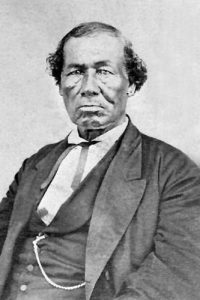The Native American groups that have lived in Miami County, Kansas include the Miami, the Confederated tribes, the Potawatomi, and the Shawnee.
The Shawnee reservation embraced a strip of land across the northern end of the county, about two and one-fourth miles in width. Some of them continued to live here until 1866, when, along with the remainder of their tribe, they relocated to the Indian Territory (present-day Oklahoma).
The Pottawatomi reservation, which was partly in Franklin County and partly in Miami County, in Mound and Osawatomie Townships, and a small portion of Stanton and Valley Townships, in all about 80 square miles, or 51,000 acres. This tribe was removed to a reservation on the Kansas River in 1847-1848, where a portion of them remained.
The Confederated Tribes were composed of the Wea, Piankashaw, Peoria, and Kaskaskia. They inhabited the northern part of the county, bordering the Shawnee Reservation. Upon their removal here, they were but remnants of previously large and powerful tribes. The Wea were once part of the Miami tribe, with their language being almost identical to that of the Miami. The Confederated Tribes formerly lived in Southern Illinois. In 1818, they removed to Eastern Missouri and settled near St. Genevieve.
In 1827, the Wea and Piankashaw moved to what is now Miami County; the Peoria followed in a year or two, and the Kaskaskia arrived in 1832. From this time until 1854, these tribes continued to live in undisturbed possession of their reservation, when it became necessary to open the country to settlement. A treaty was made between them and the Government by which they sold all their lands except for 160 acres for each member of the tribe, ten sections for tribal purposes, and one section for the support of a Mission School. In the formation of this treaty, Colonel Manypenny represented the Government, and Kio-kun-no-zah, Yellow Beaver, and others served as chiefs of the Indians; Baptiste Peoria acted as interpreter.
As white settlers came in and filled up the county, the Confederated tribes made preparations to make one more removal. With the government’s consent, a delegation from the tribes purchased a portion of the Quapaw and Seneca lands in the Indian Territory in 1866. The purchase was ratified by treaty in 1868, and most of the Confederated tribes removed to their new homes on Spring River that year. Many of those who remained were granted citizenship and became prosperous members of the community, while others have since migrated to the Indian Territory.
When the Treaty of 1854 was made, the Confederated Tribes numbered 260, but their numbers have steadily declined since then.
At least two of the members of the Confederated tribes are worthy of brief mention: Win-ris-cah, or Christmas Dagnette, and Baptiste Peoria.
The former was born near Terre Haute, Indiana, around 1800. He was a nephew of a Wea chief and received a liberal education. Besides three or four Indian languages, he could speak English, French, and Spanish, and at the age of sixteen, he acted as an interpreter for the Government. He relocated to Kansas with his tribe, where he served as chief for several years, and died in 1848.
Baptiste Peoria was born around the year 1800, near Kaskaskia, Illinois. He did not receive a formal education in school. Still, by the natural force of his intellect, he acquired a number of Indian languages, including Shawnee, Delaware, and Pottawatomi, as well as those of the several Confederated Tribes, and also English and French. He acted for many years in the capacity of interpreter, and for some time as chief, but generally preferred to be on the “outside” as there he could be of much more use to his tribe, which during almost the whole of his long life continued to look up to him as their best advisor. When the tribes removed to the Indian Territory, Baptiste went with them and died there in the year 1874. He was a man of extensive and enlightened views and was distinguished for the virtues that spring from a kindly heart and generous spirit. His widow, who was the widow of Christmas Dagnette at the time of their marriage, resided in Paola at the ripe age of 82, loved and respected by all who knew her.
The Miami were the first settlers in Miami County. They, as a portion of the Shawnee, were originally from Ohio. They were removed to Indiana by General Anthony Wayne in accordance with the treaty of August 3, 1795. In 1840, a treaty was signed by which they agreed to relocate to new homes in the Indian Territory (now Kansas). In 1846, 800 Miami, located in the southeast part of the present-day Miami County, were on Sugar Creek. In 1847, about 300 more arrived, and in 1848, about 500 of them returned to Indiana, which return was afterwards acquiesced in by an act of Congress.
In the same year, those remaining in Miami in the county were relocated from their homes in Sugar Creek to the Marias des Cygnes River, located in the central southern portion of the county, near what has since been known as Miami Village. The removal was caused by sickness, superinduced by change of climate, privation, and exposure. In three years from the time of their arrival on Sugar Creek, their number was reduced by death from 600 to 300, one-half the deaths occurring on Sugar Creek. Their principal burying ground was then about two miles southeast of the present village of Rockville.
The original Miami reservation encompassed approximately 500,000 acres of land. It was bounded on the east by Missouri, on the south by the reservation of the New York Indians, on the west by the Pottawatomi reservation, and on the north by that of the Confederated tribes. In 1854, as white settlers began to establish homes on the Miami reservation, the Government purchased all but 72,000 acres. Colonel Manypenny acted on behalf of the Government, and Now-a-lun-qua (“Big-Legs”) represented the Miami, with Jack Hackley serving as interpreter.
The Miami remained on this remnant of their reservation until 1871, when, having been reduced to about 130 in number, most of them removed to the Neosho River in the Indian Territory. A few remained and became American citizens, making considerable progress in agriculture and becoming useful, upright, and respected members of society.
The agents for these tribes have been the following: Colonel Ely Moore, until 1854; Colonel A. M. Coffey, 1854 to 1855; Colonel M. McCaslin, 1855 to 1857; General Seth Clover, 1857 to 1861; Colonel G. A. Colton, 1861 to 1869; James Stanley, 1869 to the time the Agency was abolished. President James Buchanan removed Colonel McCaslin for having protested against the invasion of Kansas by Missourians. He was Colonel of the Fifteenth Virginia Infantry during the rebellion.
Compiled by Kathy Alexander/Legends of America, updated October 2025..
Also See:
Native American Photo Galleries
Native Americans – First Owners of America
Source: Cutler, William G.; History of Kansas; A. T. Andreas, Chicago, IL, 1883.




